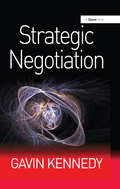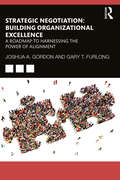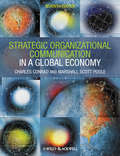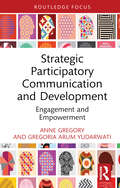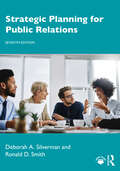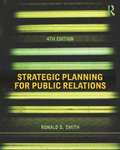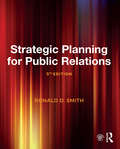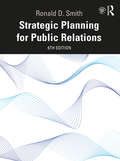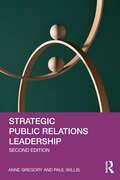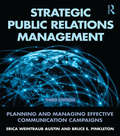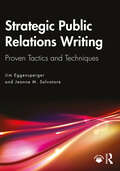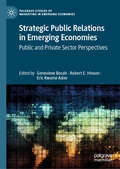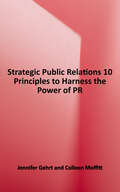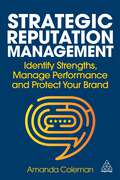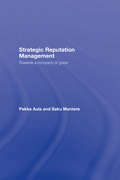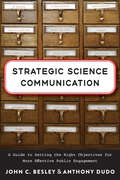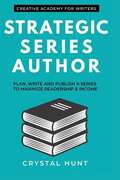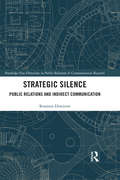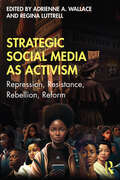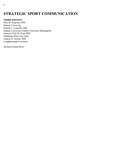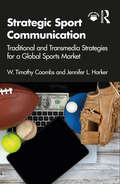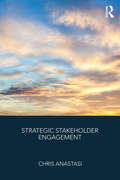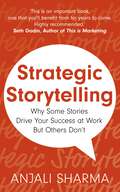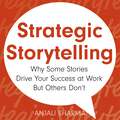- Table View
- List View
Strategic Negotiation
by Gavin KennedyA first-rate organizational business plan demands an understanding of the dynamics behind remuneration, joint ventures, partnerships, alliances, major contracts; in fact, all of the commercial imperatives that will define success or failure over a five-year (or longer) period. And realizing this plan will involve complex and often multi-level or multi-party negotiations. The scale and context of these negotiations requires a level of strategic awareness because the interests of the parties are more complex, the options more numerous, and the outcomes more critical than at a tactical level. Strategic Negotiation is written for senior executives who provide input to or assessment of their organization's medium or long-term planning process, and who are engaged in implementing any aspects of their organization's plans. Part One focuses on the foundations of strategic negotiation: the commercial imperatives - what the organization must do to restructure and resource its operations to achieve commercial success - and the negotiation strategies associated with each. It also explains the logistics of managing complex public and private sector negotiations. Part Two includes the tools for successful negotiation: bid strategies; techniques for analyzing your position before you start and reassessing it during the negotiation; and the negotiation agenda and how to design and compile it. If you are operating at a senior level where negotiations are, by their nature, high value, complex, multi-level and often multi-party, what better guide than Gavin Kennedy, a long-standing world expert on negotiation, and his book Strategic Negotiation?
Strategic Negotiation: A Roadmap to Harnessing The Power of Alignment
by Gary Furlong Joshua GordonEmpowering organizations to thrive, this book provides a clear diagnostic framework with specific approaches and processes that leaders can use to build a negotiation function that will succeed each and every time.Negotiation is a required skill and a core competency, but most organizations focus exclusively on individual negotiation skills and abilities and pay little attention to the internal culture and environment that shapes and guides these individuals. This book takes a dramatically different approach to building success in each and every negotiation, producing results that align with organizational strategy at all levels.Professionals in sales, procurement and supply chain, human resources, change management, mergers and acquisitions, contracts, start-ups, construction partnering, and training consultants and students of business and law will value a text that understands how to build negotiation skills and capability across the organization by aligning individual skills with an evidence-based approach that actually works.
Strategic Negotiation: A Roadmap to Harnessing The Power of Alignment
by Gary T. Furlong Joshua A. GordonEmpowering organizations to thrive, this book provides a clear diagnostic framework with specific approaches and processes that leaders can use to build a negotiation function that will succeed each and every time.Negotiation is a required skill and a core competency, but most organizations focus exclusively on individual negotiation skills and abilities and pay little attention to the internal culture and environment that shapes and guides these individuals. This book takes a dramatically different approach to building success in each and every negotiation, producing results that align with organizational strategy at all levels. Professionals in sales, procurement and supply chain, human resources, change management, mergers and acquisitions, contracts, start-ups, construction partnering, and training consultants and students of business and law will value a text that understands how to build negotiation skills and capability across the organization by aligning individual skills with an evidence-based approach that actually works.
Strategic Organizational Communication: In a Global Economy
by Marshall Scott Poole Charles ConradSurveying a wide variety of disciplines, this fully-revised 7th edition offers a sophisticated and engaging treatment of the rapidly expanding field of organizational communication Places organizations and organizational communication within a broader social, economic, and cultural context Applies a global perspective throughout, including thoughtful consideration of non-Western forms of leadership, as well as global economic contexts Offers a level of sophistication and integration of ideas from a variety of disciplines that makes this treatment definitive Updated in the seventh edition: Coverage of recent events and their ethical dimensions, including the bank crisis and bailouts in the US and UK Offers a nuanced, in-depth discussion of technology, and a new chapter on organizational change Includes new and revised case studies for a fresh view on perennial topics, incorporating a global focus throughout Online Instructors' Manual, including sample syllabi, tips for using the case studies, test questions, and supplemental case studies
Strategic Participatory Communication and Development: Engagement and Empowerment
by Anne Gregory Gregoria Arum YudarwatiThere has been a recent shift in the nature of public engagement from a culture of paternalism and control towards a public-centred approach involving collaboration and co-creation. This book draws on public relations and development communication insights to build a new community engagement model for public sector organisations who wish to engage with rural communities in developing countries. This theoretical model also offers a practical framework for Government in particular to engage with and empower rural communities as they adopt and exploit infrastructure developments. The outcome is mutual benefit.By examining in detail how Government communicates with rural communities on renewable energy infrastructure projects in Indonesia, and underpinned by empirical research with those communities, this new participatory framework has been developed. It envisages progressive empowerment of rural communities as Government encourages active engagement on the installation and exploitation of renewable energy. This entails encouraging communities to determine for themselves their uses of sustainable energy sources and to take ownership of a co-determined future. In so doing, the Government itself is more likely to achieve its own renewable energy commitments.Research-based and combining theory with practice, this thought-provoking book will be welcomed by strategic communication and public relations scholars and practitioners alike.
Strategic Planning for Public Relations
by Ronald D. Smith Deborah A. SilvermanThe seventh edition of Strategic Planning for Public Relations maintains its status as a leading text to guide students in developing successful public relations campaigns.Deborah Silverman and Ronald Smith bring their experience as instructors and public relations professionals to the book, providing clear, step-by-step guidance on how to plan and implement strategic communications campaigns. This new edition includes diverse examples of current cases along with classic cases that stand the test of time. It includes new “Ethics Minutes” scenarios in each step, a new research step, and examples of award-winning public relations campaigns. It also significantly increases information on social media and features a reformatting of the tactics step into four separate parts based on the PESO model (paid media, earned media, shared media, and owned media).As a leader in teaching public relations strategy, this text is ideal for students in upper division undergraduate and graduate courses in public relations strategy and campaigns.Complementing the book are online resources for both students and instructors. For students: step overviews, useful links to professional organizations and resources, checklists for the ten steps in the planning process, and two sample campaigns. For instructors: an instructors’ manual, PowerPoint slides, sample syllabi, a critique evaluation worksheet, and checklists for the ten steps in the planning process. For these online resources, please visit www.routledge.com/9781032391168 .
Strategic Planning for Public Relations
by Ronald D. SmithThis innovative and popular text provides a clear pathway to developing public relations campaigns and other types of strategic communication. Implementing the pragmatic, in-depth approach of the previous editions, author Ronald D. Smith presents a step-by-step unfolding of the strategic campaign process used in public relations practice. Drawing from his experience in professional practice and in the classroom, Smith walks readers through the critical steps for the formative research, strategic and tactical planning, and plan evaluation phases of the process. Offering clear explanations, relevant examples, and practical exercises, this text identifies and discusses the decision points and options in the development of a communication program. The cases and examples included here explore classic real-world public relations situations as well as current, timely events. This fourth edition highlights the results of new research studies on opinions and practices within the discipline, and adds overviews of several award-winning public relations campaigns. As a classroom text or a resource for professional practice, this volume provides a model that can be adapted to fit specific circumstances and used to improve effectiveness and creativity in communication planning. It serves as an accessible and understandable guide to field-tested procedures, offering practical insights that apply to public relations campaigns and case studies coursework.
Strategic Planning for Public Relations
by Ronald D. SmithStrategic Planning for Public Relations is in its fifth edition of offering an innovative and clear approach for students looking to learn how to develop public relations campaigns. It is a text intended for those serious about entering the rapidly changing professions of public relations and strategic communication. Ronald Smith shows how to implement pragmatic, research-driven strategic campaigns used in public relations practice, and draws from his years of experience as a professional in the industry and his years of teaching in the classroom. The approach used in this text is a threefold pattern: first, readers are exposed to new ideas, then see them in use, before finally being showed how to apply those ideas themselves. Complex problem-solving and decision-making processes in strategic communication and public relations are turned into a series of easy-to-follow steps, flexible enough to be applicable to myriad situations and organizations in the real world. This new fifth edition follows the same format as previous editions and includes numerous timely and real-world examples of cases and current events, along with classic cases that stand the test of time. It includes new research on opinions and practices within the discipline and covers several recent, award-winning public relations campaigns.
Strategic Planning for Public Relations
by Ronald D. SmithThe sixth edition of Strategic Planning for Public Relations offers an innovative and clear approach for students wanting to learn how to develop public relations campaigns. Ron Smith shows how to implement research-driven strategic campaigns, drawing on his experience as a professional in the industry and his teaching in the classroom. He turns complex problem-solving and decision-making processes in strategic communication and public relations into easy-to-follow steps, flexible enough to apply to various situations and organizations in the real world. This new edition includes real-world, diverse examples of cases and current events, along with classic cases that stand the test of time. It includes new research on opinions and practices, covers award-winning public relations campaigns, and significantly increases information on social media, with a reformatting of the Tactics section to highlight internet-based and social media. As a leader in teaching public relations strategy, this text is ideal for students in upper division undergraduate and graduate courses in public relations strategy and campaigns. Complementing the book are online resources for both students and instructors. For students: chapter overviews, useful links to professional organizations and resources, and an overview of careers in public relations. For instructors: an instructors’ manual, lecture slides, and sample course materials. Please visit www.routledge.com/cw/smith.
Strategic Public Relations Leadership
by Paul Willis Anne GregoryPublic relations professionals are operating in an increasingly challenging and complex environment. Pressures from outside the organisation include new accountabilities, empowered stakeholders, increased public cynicism and a new communication landscape. Internally, there are increasing demands to demonstrate a strategic contribution, alongside a requirement to coach and counsel senior managers exposed to these environmental pressures. This revised and updated edition provides a framework to enable public relations professionals to clearly articulate and demonstrate their own contribution to organisational effectiveness, while also setting out the specific capabilities public relations leaders must exhibit to operate at the highest levels of the organisation. This edition further develops the pioneering approach to integrating thinking around public relations, leadership, and strategy. It has been updated comprehensively to address contemporary developments and introduce new research and fresh perspectives from the authors. New to this edition are insights from Chief Executives on what they expect from public relations leaders and a comprehensive set of capabilities which scope the demanding role of professionals at the top of their game. Concise and practical, this textbook is suitable for MBA and other postgraduate and executive education qualifications in Public Relations and Corporate Communications – especially for those students who wish to pursue a successful career as a professional public relations specialist, able to operate strategically at the top of successful organisations.
Strategic Public Relations Management: Planning and Managing Effective Communication Campaigns (Routledge Communication Series #10)
by Erica Weintraub Austin Bruce E PinkletonStrategic Public Relations Management features an applied approach to evidence-based, strategic public relations management. It emphasizes understanding audiences through research and demonstrates success through quantitative evaluation methods. The volume presents a scientific approach that helps future and current practitioners understand and communicate the value of public relations to others, using performance metrics to demonstrate return on investment. New to the third edition: New examples on the effective use of digital communication and online research tools; Updated guidance on researching using digital tools and social media; New examples that provide a more accessible pathway to real-world application. In addition to these new features, the book covers: Creating a framework for planning; Up-to-date research tools and how to develop a research plan; Gathering useful data for strategic guidance; Real-world examples that provide readers with realistic cases and situations; Applying theory to professional practice. The book's accessibility will be welcomed by instructors and students with definitions of terms, a how-to approach, and an accessible style of writing throughout.
Strategic Public Relations Writing: Proven Tactics and Techniques
by Jim Eggensperger Jeanne SalvatorePutting strategy front and center, this public relations writing textbook coaches students to readiness for a career as an effective strategic communicator. The book focuses on the strategic aspect of public relations writing that distinguishes it from other writing, such as journalistic or academic. It highlights the essential types of writing necessary for effective public relations in multiple media channels, demonstrated by contemporary cases direct from practitioners working today. Overviews of the various tactical formats that must be mastered for powerful, strategic public relations—ranging from social media posts and website updates to podcasts, speeches and infographics—prepare students to be effective and up-to-date professionals. Full of examples and exercises, the book’s strength is in its practical utility for career preparation and success. This text is suited to public relations writing courses at the undergraduate and postgraduate level, particularly those with a focus on strategy or that combine strategy and writing into one course. Online resources include chapter outlines; a testbank; sample homework, paper and portfolio-building assignments; and lecture slides. They can be accessed at www.routledge.com/ 9781032163871.
Strategic Public Relations in Emerging Economies: Public and Private Sector Perspectives (Palgrave Studies of Marketing in Emerging Economies)
by Robert E. Hinson Eric Kwame Adae Genevieve BosahThis book examines the nuances of public relations in the developing world. Offering a comprehensive exploration, description, analysis, and explanation of diverse PR strategies, tactics, and challenges, authors draw on insights from both the public and private sectors of developing societies. The chapters explore the unique cultural nuances, socio-political contexts, and emerging trends that continue to shape PR practices in emerging economies. The book examines how to effectively navigate complex regulatory environments, build strong relationships with publics, and leverage innovative communication strategies to achieve impactful results in the public and private sectors. This must-have book provides valuable insights into the challenges and opportunities facing PR professionals in emerging markets.
Strategic Public Relations: 10 Principles to Harness the Power of PR
by Jennifer Gehrt Colleen MoffittStrategic Public Relations is a modern blueprint for building truly effective PR communications. It's A Fact: PR helps build successful businesses. Yet, with 24/7 news channels and an ever-increasing blur of Internet activity, the public relations landscape is radically changing. Strategic Public Relations offers practical principles as well as precise, useful pointers to help readers understand the morphing landscape and leverage contemporary PR to achieve maximum benefit.
Strategic Reputation Management: Identify Strengths, Manage Performance and Protect Your Brand
by Amanda ColemanIn today's hyper-connected world, reputation is everything. This book explores the role of reputation management within your organization, providing the latest insights and strategies to help you navigate it.Strategic Reputation Management is a practical guide that equips PR and communication professionals with the tools they need to navigate the complexities of reputation management effectively. With a wealth of practical tips and strategies, readers will gain the knowledge and expertise needed to enhance or build their organization's reputation.Using real-world examples and expert interviews, this book will look at reputation management both before, during and after a crisis. It will consider how to establish a positive reputation, to maintain it when under pressure and to turn a bad reputation around after problems have occurred. It will also include top tips, checklists and outline a new framework for reputation management.Strategic Reputation Management is a must-read for anyone seeking to understand, manage and master the intricate world of reputation management.
Strategic Reputation Management: Towards A Company of Good
by Pekka Aula Saku MantereStrategic Reputation Management examines the ways in which organizations achieve "goodness" through reputation, reputation management and reputation strategies. It presents a contemporary model of strategic reputation management, helping organizations and stakeholders to analyze the business environment as a communicative field of symbols and meanings in which the organization is built or destroyed. Authors Pekka Aula and Saku Mantere introduce the eight generic reputation strategies, through which organizations can organize their stakeholder relationships in various ways. They illustrate their arguments using real-world examples and studies, from the Finnish Ski Association to Philip Morris International.This book serves as required reading in advanced courses covering public relations practice, advanced topics in PR, corporate communication, management, and marketing. Professionals working in PR, business, management and marketing will also find much of interest in this volume.
Strategic Science Communication: A Guide to Setting the Right Objectives for More Effective Public Engagement
by Anthony Dudo John C. BesleyWhat tactics can effective science communicators use to reach a wide audience and achieve their goals?Effective science communication—the type that can drive behavior change while boosting the likelihood that people will turn to science when faced with challenges—is not simply a matter of utilizing social media or employing innovative tactics like nudges. Even more important for success is building long-term strategic paths to achieve well-articulated goals. Smart science communicators also want to create communication opportunities to improve their own thinking and behavior.In this guidebook, John C. Besley and Anthony Dudo encapsulate their practical expertise in 11 evidence-based principles of strategic science communication. Among other things, science communicators, they argue, should strive to seem competent, warm, honest, and willing to listen. Their work should also convey a desire to make the world a better place. Highlighting time-tested methods for building rapport with an audience through several modes of communication, Besley and Dudo explain how to achieve each strategic objective. All scientific communication is goal-oriented, and Besley and Dudo discuss the importance of recognizing the right goals, then employing strategic and tactical communication in order to achieve them. Finally, they offer specific suggestions for how practitioners can evaluate the effectiveness of their communications (and in fact, build evaluation into their plans from the beginning).Strategic Science Communication is the first book to use social science to help scientists and professional science communicators become more evidence-based. Besley and Dudo draw on insightful research into the science of science communication to provide readers with an opportunity to think more deeply about how to make communication choices. This guidebook is essential reading for all professionals in the field.
Strategic Series Author: Plan, Write and Publish a Series to Maximize Readership and Income (Creative Academy Guides for Writers Series)
by Crystal HuntWriting series can be a great way to level up your author career, create a more stable writing income, and create a devoted fanbase. It's also challenging, and can be overwhelming if you're not prepared. Series authors need to consider many things that standalone title authors don't have to worry about. And everything is exponentially more complex once you're tackling more than one book! You might be wondering: What kind of series should I write? Which details do I need to keep track of? How much advance planning should I do? Is publishing strategy different for a series vs standalone titles? How can I get the most bang for my buck in marketing and promotion Experienced series author Crystal Hunt will help you answer all these questions and more with this combination strategy manual and exercises that will get you applying what you've learned to your own series project. Whether you're a seasoned series author, or just starting to explore your options and thinking a series might be a good next step for you, this book can help you write and publish your series smarter from ideas through publication and promotion! This is the third book in the Creative Academy Guides for Writers series. Be sure to check out the rest of the guides for writers in this series.
Strategic Silence: Public Relations and Indirect Communication (Routledge New Directions in PR & Communication Research)
by Roumen DimitrovMainstream public relations overvalues noise, sound and voice in public communication. But how can we explain that while practitioners use silence on a daily basis, academics have widely remained quiet on the subject? Why is silence habitually famed as inherently bad and unethical? Silence is neither separate from nor the opposite of communication. The inclusion of silence on a par with speech and non-verbal means is a vital element of any communication strategy; it opens it up for a new, complex and more reflective understanding of strategic silence as indirect communication. Drawing on a number of disciplines that see in silence what public relations academics have not yet, this book reveals forms of silence to inform public relations solutions in practice and theory. How do we manage silence? How can strategic silence increase the capacity of public relations as a change agent? Using a format of multiple short chapters and practice examples, this is the first book that discusses the concept of strategic silence, and its consequences for PR theory and practice. Applying silence to communication cases and issues in global societies, it will be of interest to scholars and researchers in public relations, strategic communications and communication studies.
Strategic Social Media as Activism: Repression, Resistance, Rebellion, Reform
by Adrienne A. Wallace and Regina LuttrellDrawing on a range of theoretical and empirical perspectives, this volume examines the roles strategic communications play in creating social media messaging campaigns designed to engage in digital activism. As social activism and engagement continue to rise, individuals have an opportunity to use their agency as creators and consumers to explore issues of identity, diversity, justice, and action through digital activism. This edited volume situates activism and social justice historically and draws parallels to the work of activists in today’s social movements such as modern-day feminism, Black Lives Matter, #MeToo, Missing Murdered Indigenous Women, and We Are All Khaled Said. Each chapter adds an additional filter of nuance, building a complete account of mounting issues through social media movements and at the same time scaffolding the complicated nature of digital collective action. The book will be a useful supplement to courses in public relations, journalism, social media, sociology, political science, diversity, digital activism, and mass communication at both the undergraduate and graduate level.
Strategic Sport Communication
by Edward Kian Pamela C. Laucella Paul M. Pedersen Andrea N. GeurinStrategic Sport Communication, Third Edition, presents a comprehensive examination of the evolving field of sport communication. With a complete approach to the multifaceted and interrelated applications of sport communication, this text will help the reader understand modern trends and industry demands. The book’s topics align with the Common Professional Component topics outlined by the Commission on Sport Management Accreditation (COSMA). <p><p> Organized into three parts for easy understanding, part I familiarizes students with the field by defining sport communication, presenting historical analysis, and providing an extensive discussion of career opportunities. Part II focuses on the elements of the Strategic Sport Communication Model (SSCM). This model details the three main components of sport communication: personal and organizational aspects of communication, mediated communication in sport, and sport communication services and support systems. Students will understand how each component plays an integral role in sport management, sport marketing, and operational goals at all levels of sport organizations. Part III examines legal aspects and critical sociological and cultural issues. <p><p> Significant updates throughout the third edition capture the evolution of sport communication: <p>• A look at emerging communication platforms and modern technologies such as fantasy sports and online gambling <p>• New content covering the cutting-edge topics of customer-centric marketing, influencer marketing, the rise of digital media in integrated marketing, and the use of data analytics in marketing communication <p>• A new discussion of digital public relations tools and new examples of crises in sport, including a case study that provides a real-world example of a crisis in sport communication <p>• Learning aids—including key terms, chapter objectives, and chapter wrap-ups with review questions and individual exercises—provide for an engaging and focused learning experience <p>• Updated for this edition, Sport Communication at Work sidebars feature industry experts applying chapter content, and Profile of a Sport Communicator sidebars highlight professional opportunities. <p><p> In Strategic Sport Communication, Third Edition, students will develop a thorough understanding of the vast and varied field of sport communication. As the exciting field of sport communication continues to present new challenges, the analysis provided within this text will provide the foundational and theoretical understanding necessary for aspiring sport communication professionals to succeed.
Strategic Sport Communication: Traditional and Transmedia Strategies for a Global Sports Market
by W. Timothy Coombs Jennifer L. HarkerAuthors Coombs and Harker provide step-by-step guidance on how the strategic communication process—an integration of marketing communication, public relations, and advertising—can be applied to sports communication for individual athletes, teams, and leagues. The book is founded on the premise that the strategic communication process in sport communication is grounded in understanding the fans and sources of revenue. Looking at sports globally, it offers readers the traditional multi-step, linear approach to strategic communication message development along with the transmedia narrative transportation method, a non-linear approach that centers on narratives to engage target audiences and urge them to contribute their own material to messaging. With case studies and practical examples, it also highlights additional issues such as race and gender, social media, ethics, and athlete health. It is an ideal text for undergraduate and graduate courses in public relations or strategic communication and sport communication. An online instructor’s manual accompanies the text, including lecture slides; a sample strategic sports communication plan; a test bank; links to key web sites that discuss sports and sports communication concerns; links to case studies with class discussion prompts; sample assignments; a sample course syllabus; and suggestions for further reading.
Strategic Stakeholder Engagement: A Voice Behind The Curtain
by Chris AnastasiIs it your objective to bring about positive change for your business or organisation by influencing the policy and regulatory environment in which you operate? Do you need to know how to engage with decision-makers in government and other key influencers? Are you looking to pursue or advance your career in Public Relations? Ambitious practitioners working within Public Relations and Corporate Social Responsibility, inside or outside government respectively, and in private or non-profit organisations, will find this an invaluable guide.Revealing insights into the inner workings of government and drawing on real-life case studies, this book offers practical, clear, creative ideas and innovative strategies designed to empower Public Relations professionals to engage with key stakeholders effectively and to influence government policy and regulation. At a time of considerable uncertainty and ever-evolving government policy and regulation, this book shows how it is possible for businesses and organisations to have a voice and make an impact. Chris Anastasi, a recognised authority in Public Relations, has helped national and global organisations influence government and effect major change. He now offers Public Relations practitioners an unmissable chance to become even more effective influencers through his book. Strategic Stakeholder Engagement is essential high-quality reading for anyone involved in public relations, government affairs, lobbying and social responsibility activities in countries around the world.
Strategic Storytelling: Why Some Stories Drive Your Success at Work But Others Don’t
by Anjali SharmaIn today's connection economy, the most successful leaders inspire their people with purpose and meaning. Powerful corporate storytelling can mobilise people around an organisational objective in a way that a focus on market share never will. Be it a digital transformation or a diversity and inclusion initiative, corporate change needs the support of the people in that organisation in order to stick.Yet, while all stories can move people to take action, storytelling isn't a one size fits all. The most effective influencers learn to flex their narrative based on the audience's time or their level of expertise.A story that works on the stage doesn't work in the boardroomA story that works in the boardroom doesn't work in a team meetingA story that works in a team meeting doesn't work in a one-to-one conversation A story that works in one-to-one conversation doesn't work in sales...Anjali Sharma introduces leaders and ambitious influencers to the Who, Why and How of strategic storytelling in business, enabling them bring about change and drive corporate success by telling exactly the right story in the right way.
Strategic Storytelling: Why Some Stories Drive Your Success at Work But Others Don’t
by Anjali SharmaHow to use storytelling to motivate people in your organisation, drive results and advance your careerIn today's connection economy, the most successful leaders inspire their people with purpose and meaning. Powerful corporate storytelling can mobilise people around an organisational objective in a way that a focus on market share never will. Be it a digital transformation or a diversity and inclusion initiative, corporate change needs the support of the people in that organisation in order to stick.Yet, while all stories can move people to take action, storytelling isn't a one size fits all. The most effective influencers learn to flex their narrative based on the audience's time or their level of expertise.A story that works on the stage doesn't work in the boardroomA story that works in the boardroom doesn't work in a team meetingA story that works in a team meeting doesn't work in a one-to-one conversation A story that works in one-to-one conversation doesn't work in sales...Anjali Sharma introduces leaders and ambitious influencers to the Who, Why and How of strategic storytelling in business, enabling them bring about change and drive corporate success by telling exactly the right story in the right way.(P) 2023 Hodder & Stoughton Limited
